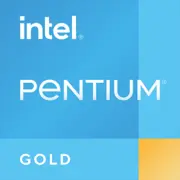Intel Pentium Gold 8505

Intel Pentium Gold 8505: Budget Processor for Everyday Tasks
March 2025
The Intel Pentium Gold 8505 processor, released as part of the 12th generation (Alder Lake), continues to be a popular choice for budget laptops. Despite newer models emerging by 2025, this chip remains relevant due to its balance of price, energy efficiency, and sufficient performance for basic tasks. Let's explore who this processor is suitable for and what to consider when purchasing a device based on it.
Architecture and Technology: Hybrid Approach and Modest Ambitions
Hybrid Cores and Intel 7 Technology
The Pentium Gold 8505 is built on the hybrid Alder Lake architecture, which combines Performance (P-cores) and Efficient (E-cores) cores. In this case, the configuration is modest:
- 1 P-core with Hyper-Threading support (2 threads);
- 4 E-cores without Hyper-Threading (4 threads).
In total: 5 cores and 6 threads. The maximum frequency of P-cores in turbo mode reaches 4.4 GHz, with base frequencies lower:
- P-core: 1.2 GHz (base), 4.4 GHz (turbo);
- E-cores: 0.9 GHz (base), 3.3 GHz (turbo).
The Intel 7 process (10nm Enhanced SuperFin) ensures good energy efficiency, and the integrated graphics Intel UHD Graphics for the 12th generation (Xe-LP, 48 EU) handles basic multimedia tasks. However, it is not a gaming solution; by 2025, even mobile APUs from AMD (such as the Radeon 740M) offer twice as many execution units.
Power Consumption and TDP: A Balance Between Performance and Battery Life
The processor's TDP is 15 W, which is typical for ultrabooks and thin laptops. In turbo mode, power can briefly rise to 20–25 W, but the cooling systems of budget devices are rarely designed for sustained loads.
Energy-Saving Technologies:
- Intel Dynamic Tuning 2.0 — automatically adjusts frequencies and voltage based on load;
- Speed Shift — instant switching between power consumption modes;
- Disabling unused cores — E-cores are activated only during multitasking.
These features lower power consumption in idle mode to 2–3 W, which is critical for battery life.
Performance: Modest, But Sufficient
Real-World Scenario Tests
- Office Work (Chrome, Excel, Zoom): The processor easily handles 10–15 tabs, documents, and video conferences. There are no delays; however, when simultaneously running "heavy" PDF files and Excel with macros, E-cores may struggle to keep up with the load.
- Multimedia: 4K video plays without issues (hardware acceleration through Quick Sync), but rendering a 10-minute video in DaVinci Resolve takes 25–30 minutes (compared to 15 minutes for the Ryzen 5 7530U).
- Gaming: CS2 at minimum settings in 720p delivers 30–40 FPS, while Fortnite runs at 20–25 FPS. This is not the best choice for gaming.
Turbo Mode activates during short loads (such as opening an application), but in sustained mode (like rendering), P-core frequencies drop to 3.8–4.0 GHz due to overheating in thin cases.
Use Cases: Who Is the Pentium Gold 8505 Suitable For?
- Students: Working on texts, presentations, online courses.
- Office Workers: Emails, spreadsheets, video calls.
- Home Users: Surfing, streaming, light photo editing.
Not Suitable For:
- Gamers — weak graphics;
- Designers/Video Editors — poor multithreading;
- Enthusiasts — lack of overclocking and limited TDP.
Battery Life: Up to 10 Hours Under Ideal Conditions
Laptops with the Pentium Gold 8505 (like the Lenovo IdeaPad 3 or Acer Aspire 5) are equipped with 40–50 Wh batteries. In real-world usage, this results in:
- 8–10 hours when working with documents and moderate brightness;
- 5–6 hours watching YouTube;
- 3–4 hours in multitasking mode (video call + browser).
Tip: Disable Turbo Boost in Windows power settings to increase battery life by 15–20% — P-core frequencies will be limited to 1.2 GHz, but that will suffice for office tasks.
Comparison with Competitors
AMD Ryzen 3 7320U (Mendocino, 6nm):
- 4 cores/8 threads, Radeon 610M (2 CU);
- Geekbench 6: 1850 (Single), 4200 (Multi);
- Better in multithreading, but more expensive (laptops from $500).
Apple M1 (2020):
- 8 cores (4+4), 7-core graphics;
- Geekbench 6: 2300 (Single), 8500 (Multi);
- MacBook Air M1 starts at $800 — this is a different price segment.
Intel Core i3-1215U (Alder Lake):
- 2 P-cores + 4 E-cores, 96 EU Xe Graphics;
- Geekbench 6: 2100 (Single), 5500 (Multi);
- Laptop prices start at $600.
Conclusion: The Pentium Gold 8505 is the most affordable option (devices starting at $400), but it even falls short compared to budget Ryzen and Core i3 in multitasking.
Pros and Cons
Strengths:
- Low laptop prices;
- Energy efficiency;
- Sufficient for basic tasks;
- Supports Wi-Fi 6 and Thunderbolt 4 (depending on the laptop model).
Weaknesses:
- Weak integrated graphics;
- Limited multithreading;
- Quick heating in turbo mode.
Recommendations for Choosing a Laptop
- Type of Device: Ultrabook or budget laptop (HP 15, ASUS VivoBook).
- What to Pay Attention To:
- Screen: Full HD (at least), IPS panel;
- RAM: 8 GB (preferably 16 GB for Windows 11);
- Storage: SSD 256 GB (preferably NVMe);
- Ports: USB-C with charging support, HDMI.
Avoid:
- Devices with HDD and 4 GB RAM;
- Laptops with TN screens — outdated color reproduction.
Final Verdict
The Intel Pentium Gold 8505 is a great choice for those looking for an affordable laptop (around $400–$550) for studying, document work, and browsing. Its key advantages are energy efficiency and low price, but it is not suited for gaming or professional tasks. If your budget allows for an additional $100–150, consider options with Ryzen 5 or Core i3 — they will last longer and handle a wider range of tasks.
Basic
CPU Specifications
Memory Specifications
GPU Specifications
Miscellaneous
Benchmarks
Compared to Other CPU
Related CPU Comparisons
Share in social media
Or Link To Us
<a href="https://cputronic.com/cpu/intel-pentium-gold-8505" target="_blank">Intel Pentium Gold 8505</a>

